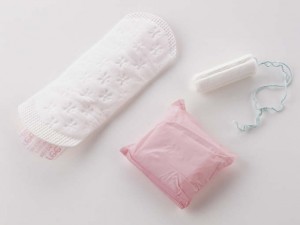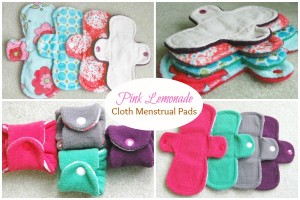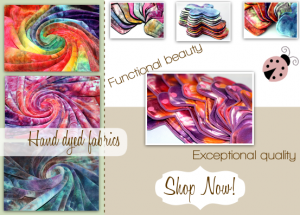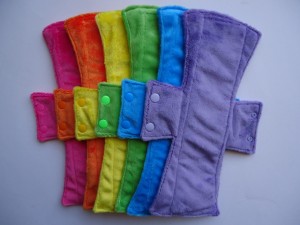Have you ever considered what is in disposable maxi pads or tampons?
 The majority of us have probably never even given thought to what effects these kinds of products have on the normal working balance of our bodies and our womanly cycles. It would seem common sense that anything inserted into the body is going to have some kind of effect on the bodies homeostasis balance. Tampon companies frequently do not list the ingredients in their tampon products, or in the least they give vague descriptions such as “fiber finishes” or “fragrance,” without listing specifically what those finishes are or what actually makes up that fragrance so that you can make an informed decision about whether or not you want to insert that into your body to be absorbed by your vaginal wall, your cervix, your uterus and into your blood stream. Tampons have warning labels for the possible bacterial infection that can be caused by the absorbency fibers of the tampon, known as TSS (Toxic Shock Syndrome). However, there are no warnings about the many chemicals and carcinogens within the products as well. Women who have used tampons have often complained of rashes, painful dryness and of course yeast and bladder infections. Perhaps there is also a direct correlation between their use and problems such as endometriosis, vulvodynia, and infertility, to name a few.
The majority of us have probably never even given thought to what effects these kinds of products have on the normal working balance of our bodies and our womanly cycles. It would seem common sense that anything inserted into the body is going to have some kind of effect on the bodies homeostasis balance. Tampon companies frequently do not list the ingredients in their tampon products, or in the least they give vague descriptions such as “fiber finishes” or “fragrance,” without listing specifically what those finishes are or what actually makes up that fragrance so that you can make an informed decision about whether or not you want to insert that into your body to be absorbed by your vaginal wall, your cervix, your uterus and into your blood stream. Tampons have warning labels for the possible bacterial infection that can be caused by the absorbency fibers of the tampon, known as TSS (Toxic Shock Syndrome). However, there are no warnings about the many chemicals and carcinogens within the products as well. Women who have used tampons have often complained of rashes, painful dryness and of course yeast and bladder infections. Perhaps there is also a direct correlation between their use and problems such as endometriosis, vulvodynia, and infertility, to name a few.
“The materials used to manufacture most pads are derived from the petroleum industry and forestry. The absorbent core, made from chlorine bleached wood pulp, could be reduced to make slimmer products with the addition of polyacrylate gels which sucks up the liquid quickly and holds it in a suspension under pressure. The remaining materials are mostly derived from the petroleum industry, the cover stock used is polypropylene non woven, with the leak-proof barrier made from polyethylene film. The extraction, production and manufacture of these plastics contributes Nitrogen oxide, sulphur dioxide and Carbon dioxide – ozone depleting gases; human toxins that lead to cancer and birth defects as well as chemicals that cause the acidification of trees.” ~ Wikipedia
Some of the known ingredients in tampons include: cotton, rayon, polyester, polyacrylate, propylene, polyethylene, fiber finishes, and dioxin, which is created during the chlorine bleaching process of the cotton and rayon.
Cotton – If you are choosing a product that contains non-organic cotton then the cotton used in these products has been sprayed by pesticides and herbicides which are known carcinogens. These pesticides and herbicides are being absorbed into your body via your most intimate organs. Each year around 84 million pounds of pesticides are used on the cotton fields of the United States. Of the top 15 pesticides in the United States, 7 of them have been declared as known human carcinogens by The Environmental Protection Agency.
Dioxin – The process by which the cotton is cleaned and sanitized for manufacturing use is known as chlorine bleaching, and it creates Dioxin. According to the National Institute of Environmental Health Services, Dioxins are chemical contaminants that are formed during a combustion processes such as waste incineration, forest fires, and backyard trash burning, as well as during some industrial processes such as paper pulp bleaching and herbicide manufacturing. Dioxin works as an anti-estrogen, by binding with Ah receptors which inhibits estrogen receptor binding, which in turn inhibits estrogen action.
Rayon – This is a man made fiber of polymers (wood pulp). Many chemicals are used in its manufacturing process as well as the chlorine bleaching process of the wood pulp which also creates dioxin. Rayon also increases the tampons absorbency, whereby increasing the risk of TSS.
Polyester – This is a synthetic fiber which is made from petroleum, coal, water and air. When these substances are combined with alcohol and acid a chemical reaction takes place, and you have polyester. It only absorbs oils, rather than moisture and it is used in the lining of maxi pads, their wrappers, coatings, and the tampon applicators.
Polyacrylate – Made form acrylic acid and sodium hydroxide, or lye, this polymer is used in feminine pads and diapers for its super absorbency. Each ingredient causes skin irritations; acrylic acid is corrosive and also negatively affects the respiratory system. Sodium hydroxide or the lye which is commonly used in the making of soaps will actually burn the skin on contact.
Polyethylene – Found in the making of pad liners, wrappers and the packaging of feminine care products. This is a thermoplastic polymer which offs-gas and is potentially a skin irritant. Plastics do not allow for good airflow to the vaginal opening which can cause a nasty and uncomfortable rash and become a breeding ground for yeast and bacterial infections.
Organic Tampons
Organic tampons contain 100% organic cotton that has not been showered in carcinogenic pesticides or herbicides. While this seems to be a much better option, the problem that still exists with this is the simple fact that something is still being inserted into the body that is not meant to be there.
Have you ever tried to remove a tampon right after inserting it?
Let’s really pause and think on this for a moment…
When you insert a dry piece of fiber into your vagina and then try and remove it immediately it feels stuck, and it is immensely discomforting, almost painful even, to pull on it for removal. As you pull, it begins to tear away at the cotton fiber of the tampon itself, often leaving a certain amount of the cotton fiber behind, still clinging to the inner wall of your vagina. But it also tears away at the lining wall of your vagina. The vaginal wall consists of fatty tissue, which easily absorbs and stores chemicals which should not be there, and very important glands that support the health and well being of the reproductive system. Both tampons and maxi pads disrupt the internal flora that is needed for healthy working womanly parts and the right balance of hormones necessary for conception. Our vagina’s are meant to be a very sacred part of our body and she needs to be treated delicately and with the utmost respect. It is important to be very cautious about what we are exposing her to (just as we are cautious about the partner we choose to share her with) whether it be a chemically laced feminine hygiene product, a personal lubricant, or a latex condom.
An Option That is Safe
For Your Body, Your Fertility, and Your Environment
 Benefits of Washable / Reusable Cloth Pads
Benefits of Washable / Reusable Cloth PadsLet’s take a look at the obvious environmental costs, as well as your personal financial cost.There is an extreme amount of waste product from the use of tampons/pads. Everything from the usable product to the packaging, the applicators, the bag the applicator/pad is individually wrapped in, to the ink and waste product during the manufacturing process in the factory to create a finished product full of pretty designs to entice you into buying a specific product over another. All of this ends up in waste landfills, or in our non-organic compost! While many packages boast about how the applicators are recyclable, have you EVER placed your discarded tampon applicator into your recycle bin!? Would you really want to??? Ummm… NO, Eeeewwww!On average, a woman uses between 300-420 tampons/pads per year, at a financial cost that could be upwards of $225.00 depending on the specific brand that you prefer. If you multiply that by the average 40 years that a woman will cycle, we are talking about a cost of roughly between $8,000 – $9,000 over the course of your life. Let’s not forget the additional financial cost you have when your daughters begin their cycles, along side of yours. Some girls begin their cycles at the age of 11 and 12 years old. That is a minimum of 6 – 7 years with double or triple the cost of feminine care products per month. Many women are taken aback when they first look at the cost of buying cloth pads. While they are certainly not inexpensive when it comes to the upfront cost, they are well worth the investment. That investment is also a one time upfront cost that will more than pay for itself before the year is done and you get to keep using them for years to come, saving you hundreds and possibly thousands of dollars. They are very durable, non-staining (depending on the fabric chosen), and easy to wash and care for.Washable/Reusable cloth pads have a multitude of benefits.
- No pesticides or herbicides
- No chlorine bleaching process which means no dioxin
- No rash, drying, itching, burning
- No absorbency chemicals, which draw the blood out, rather than it flowing on its own
- No hormone disruption
- No more lines or feelings of wearing a diaper
- AMAZING absorption without sacrificing comfort
- Breathability as cloth allows air to circulate (no sticky, sweaty)
- Cycles become more regulated
- Period bleeds become less heavy
- Discomfort of headaches, cramping and bloating are drastically lessened
- Normal vaginal flora is maintained
- PMS is reduced within a few months of use due to the re-balance of essential hormones
- Decreased risk of cancer, endometriosis, vulvodynia, and infertility
- Decrease in the onset of yeast and bladder infections
- Healthier Environment for yourself, your family, your future children, and their children
- CUTE and FUN colors and designs as well as custom made sets just for you!
- Less monthly / yearly feminine hygiene expenses
There are many different companies to choose from to begin building your stash of cloth pads. My personal recommendations for a good quality cloth pad would be through Pink Lemonade Shop or Tree Hugger Mama Cloth. You can choose from amazing matching sets or build your own custom set created to your specific style! Choose your fabric, sizes and colors! Both offer great options and styles of pads sure to meet your hygienic needs. Check them out and find the one that best fits your personal needs and style.
If you have serious concerns or issues with washing your pads, then another GREAT option is the Diva Cup or the Lunette Cup!
Reference Resources and additional Readers
Green Facts on health and the environment and the deatils of the Ah receptor
Uses, history and controversies over Rayon fiber
Health safety update from Luna Pads about the reasons behind the sudden disappearance of ob tampons from retailers shelves. The truth be told.
What are sanitary pads
Natural Fertility Info on Tampons and their correlation to infertility
Basic benefits of cloth pads from Natural Family Awareness
History, current synthesis, and uses of superabsorbent polymer
National Institute of Environmental Health Sciences health and education on Dioxin
Environmental Working Group’s report and consumer guide on Dioxin
Information and facts on Polyethylene
Information and facts on Polypropylene
Pink Lemonade Cloth Pads
Tree Hugger Mama Cloth



